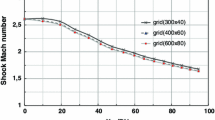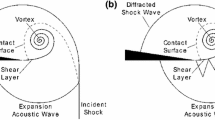Abstract
The efficiency of compression processes tends to decrease dramatically when the overall dimensions are scaled down to micron level. Then it can be assumed that the compression is more efficient if no moving parts are involved in the process. This is achieved by replacing, at least partially, turbo-compressor stages with a wave rotor. The work starts with estimating wave rotor efficiency at microscale by extrapolation. Then, an analytical model is introduced from which the theoretical efficiency of compression process in a microchannel is deduced. Knowing the inlet conditions and the pressure gain across the shock, the overall efficiency of the compression can be calculated. The model assumes constant friction along the walls and no heat exchange with the surroundings. The results suggest that an efficiency of 70–80% can be achieved in the channels of an ultra-micro wave rotor. It is shown that if the inlet temperature is high enough (about 1500 K), the efficiency is even higher, up to 90%.















Similar content being viewed by others
Abbreviations
- a :
-
Speed of sound (m/s)
- Cp :
-
Specific heat (J/kg K)
- D H :
-
Hydraulic diameter (m)
- f :
-
Friction coefficient
- γ:
-
Specific heat ratio
- Δ p :
-
Pressure drop (Pa)
- η:
-
Isentropic efficiency (%)
- ηC :
-
Isentropic compression efficiency (%)
- ηP :
-
Polytropic efficiency (%)
- L :
-
Channel length (m)
- L * :
-
Distance to sonic conditions (m)
- k :
-
Entrance loss coefficient
- M :
-
Mach number
- μ:
-
Kinematic viscosity (St)
- μref :
-
Reference viscosity (St)
- Π:
-
Pressure ratio
- p :
-
Pressure (Pa)
- PR W :
-
Wave rotor compression ratio
- R :
-
Specific gas constant (J/kg K)
- ρ :
-
Density (kg/m3)
- Re :
-
Reynolds number
- S :
-
Effective temperature (K)
- T ref :
-
Reference temperature (K)
- T :
-
Temperature (K)
- u :
-
Flow velocity (m/s)
- u p :
-
Induced flow velocity behind shock wave (m/s)
- w :
-
Shock wave velocity (m/s)
- 0:
-
Inlet port
- 1:
-
Entry of the microchannel
- 2:
-
Location before shock (relative to fixed reference frame)
- 3:
-
Location after shock (relative to fixed reference frame)
- 4:
-
Exit of the microchannel
- air:
-
Pre-compressed air from compressor
- C:
-
Compressor
- comb:
-
Combustor
- gas:
-
Exhaust gases from combustion chamber
- S:
-
Shock
- t:
-
Total (stagnation)
- T:
-
Turbine
- WC:
-
Wave rotor compression
- WT:
-
Wave rotor expansion
References
Akbari P, Müller N (2003) Performance investigations of small gas turbine engines topped with wave rotors. In: Proceedings of the 39th AIAA/ASME/SAE/ASEE joint propulsion conference, AIAA2003-4414. Huntsville, AL
Anderson JD (2003) Modern compressible flow: with historical perspective. McGraw-Hill, New York
Brouillette M (2003) Shock waves at micro scale. Shock Waves 13:3–12
Dessornes O, Dumand C, Gaffie D, Guidez J, Ribaud Y (2003) Micro combustion chambers principles dedicated to micro-turbines. Power MEMS 122–125
Dixon SL (1998) Fluid mechanics, thermodynamics of turbomachinery. Butterworth-Heinemann, Oxford, UK
Epstein AH (2003) Millimeter-scale, MEMS gas turbine engines. ASME turbo expo 2003, GT-2003-38866. Atlanta, GA
Epstein AH (2004). Millimeter-scale, micro-electro-mechanical systems gas turbine engines. J Eng Gas Turbines Power 126:205–226
Epstein AH, Ayón AA, Fréchette LG, Senturia SD (1997a) Micro-heat engines, gas turbines, and rocket engines—The MIT Microengine Project. In: Proceedings of the 28th international symposium AIAA fluid dynamics conference, AIAA Paper 97-1773. Snowmass Village, CO
Epstein AH, Senturia SD, Mehra A, Ayón AA (1997b) Power MEMS and microengines. IEEE transducers ’97 conference. Chicago, IL
Epstein AH, Jacobson SA, Protz JM, Fréchette LG (2000) Shirtbutton-sized gas turbines: The engineering challenges of micro high speed rotating machinery. In: Proceedings of the 8th international symposium on transport phenomena and dynamics of rotating machinery. Honolulu, Hawaii
Fatsis A, Ribaud Y (1999) Thermodynamic analysis of gas turbines topped with wave rotors. Aerosp Sci Technol 5:293–299
Frechette LG (2000) Development of a microfabricated silicon motor-driven compression system. Mechanical engineering. Massachusetts Institute of Technology, Cambridge, MA
Fréchette LG, Lee C, Arslan S, Liu Y-C (2003) Design of a microfabricated rankin cycle steam turbine for power generation. ASME international mechanical engineering congress& exposition, IMECE2003-42082. Washington, DC
Frechette LG, Jacobson SA, Breuer KS, Ehrich FF et al (2005) High-speed microfabricated silicon turbomachinery and fluid film bearings. J Microelectromech Syst 14(1):141–152
Iancu F, Akbari P, Müller N (2004) Feasibility study of integrating four-port wave rotors into ultra-micro gas turbines (UμGT). In: Proceedings of the 40th international symposium AIAA/ASME/SEA/ASEE joint propulsion conference and exhibit, AIAA2004-3581. Fort Lauderdale, FL
Iancu F, Piechna J, Müller N (2005) Numerical solutions for ultra-micro wave rotors. In: Proceedings of the 35th international symposium AIAA fluid dynamics conference and exhibit. Toronto, ON, Canada
Johnston JP, Kang S, Arima T, Matsunaga M, Tsuru H, Prinz FB (2003) Performance of a micro-scale radial-flow compressor impeller made of silicon nitride. International gas turbine congress, IGTC2003Tokyo OS-110. Tokyo
Kang S (2001) Fabrication of functional mesoscopic ceramin parts for micro gas turbine engines. Mechanical engineering. Stanford University, Stanford, CA
Kang S, Johnston JP, Arima T, Matsunaga M, Tsuru H, Prinz FB (2004) Microscale radial-flow compressor impeller made of silicon nitride: manufacturing and performance. J Eng Gas Turbines Power 126:358–365
Kollbrunner TA (1981) Comprex supercharging for passenger diesel car engines. SAE
Mathur A (1985) A brief review of the GE wave engine program (1958–1963). ONR/NAVAIR wave rotor research and technology workshop, NPS-67-85-008. Naval postgraduate school, Monterey, CA, pp 171–193
Moritz R (1985) Rolls-royce study of wave rotors (1965–1970). ONR/NAVAIR wave rotor research and technology workshop, Report NPS-67-85-008. Naval postgraduate school, Monterey, CA, pp 116–124
Müller N, Fréchette LG (2002) Performance analysis of brayton and rankine cycle microsystems for portable power generation. ASME international mechanical engineering congress& exposition, IMECE2002-39628. New Orleans, LA
Okamoto K, Nagashima T (2003) A simple numerical approach of micro wave rotor gasdynamic design. ISABE-2003-1213
Okamoto K, Nagashima T, Yamaguchi K (2003) Introductory investigations of microwave rotor. International gas turbine congress, IGTC 2003Tokyo FR-302, Tokyo
Papautsky I, Ameel T, Frazier AB (2001) A review of laminar single-phase flow in microchannels. ASME international mechanical engineering congress and exposition. New York, NY
Peirs J, Verplaesten F, Reynaers D (2004a) A micro gas turbine unit for electric power generation: design and testing of turbine and compressor. In: Proceedings of the 9th international conference on new actuators, ACTUATOR2004-P115. Bremen, Germany, pp 796–799
Peirs J, Reynaers D, Verplaesten F (2004b) A microturbine for electric power generation. Sens Actuators A 113:86–93
Piechna J (2005) Wave machines, models and numerical simulation. oficyna wydawnicza politechniki warszawakiej. Warsaw, Poland
Ribaud Y (2003) Internal heat mixing and external heat losses in an ultra micro turbine. International gas turbine congress, IGTC2003Tokyo OS-109. Tokyo, Japan
Sabersky RH, Acosta AJ, Hauptmann EG, Gates EM (1998) Fluid flow: a first course in fluid mechanics. Upper Saddle River, Prentice-Hall Inc, NJ
Spadaccini CM, Lee J, Lukachko S, Waitz IA, Mehra A, Zhang X (2002) High power density silicon combustion systems for micro gas turbine engines. ASME TURBO EXPO 2002, GT-2002-30082. Amsterdam, Netherlands
Sun M, Ogawa T, Takayama K (2001) Shock propagation in narrow channels. ISSW23, Fort Worth, TX
Sutherland W (1893) The laws of molecular force. Philosophical magazine 35(214)
Taussig RT (1984) Wave rotor turbofan engines for aircraft. Mechan Eng 106:60–66
Thayer WJ (1985) The MSNW energy exchanger research program. ONR/NAVAIR wave rotor research and technology workshop, NPS-67-85-008. Naval postgraduate school, Monterey, CA, pp 85–116
Wilson J, Paxson DE (1993) Jet engine performance enhancement through use of a wave rotor topping cycle. NASA-TM-4486, NASA
Xue H, Chen S (2003) DSMC simulation of microscale backward-facing step flow. Microscale Thermophys Eng 7:69–86
Ying-Tao D, Zhao-Hui Y, Meng-Yu S (2002) Gas flow characteristics in straight silicon microchannels. Chinese Phys 9:869–875
Zehnder G, Mayer A (1984) Comprex pressure-wave supercharging for automotive diesels—state-of-the-art. international congress& exposition. Detroit, MI
Zhang X, Mehra A, Ayón AA, Waitz IA (2002) Development of polysilicon igniters and temperature sensors for a micro gas turbine engine. IEEE, pp 280–283
Acknowledgments
The authors acknowledge Michigan Space Grant Consortium (MSGC) and NASA for partial funding of this research.
Author information
Authors and Affiliations
Corresponding author
Rights and permissions
About this article
Cite this article
Iancu, F., Müller, N. Efficiency of shock wave compression in a microchannel. Microfluid Nanofluid 2, 50–63 (2006). https://doi.org/10.1007/s10404-005-0054-7
Received:
Accepted:
Published:
Issue Date:
DOI: https://doi.org/10.1007/s10404-005-0054-7




